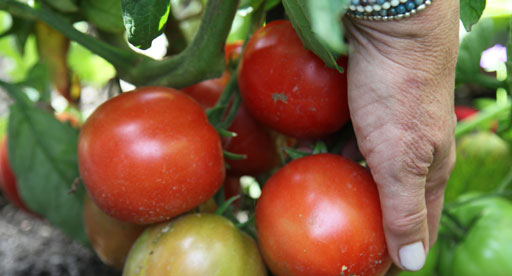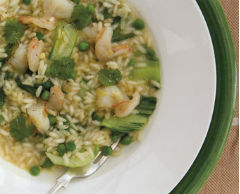
I never cease to be amazed by the long-awaited arrival of spring. It’s still freezing outside but after months of winter’s bleak, blank canvas the first signs of the new season are such a welcome relief.
Shopping list
Some years I do find myself wondering if spring will ever arrive, as the icy days of winter roll on interminably. But it eventually pulls through even the most inclement weather. Longer days, more light and just the faintest hint of heat in the sun and the soil are the triggers for the growing season to start afresh.
Before you even think about planting, you need to get the soil in tip top shape so that your plants can get the start they need to flourish. Putting in a little effort at the start of the new growing season, and remembering to water regularly once your plants are in the ground, is all it takes to grow healthy plants and an abundance of harvests.
Last spring I neglected to put the effort into properly preparing a couple of my garden beds and the lack of growth and performance was quite astonishing – small, weak plants, with little in the way of harvests. I have found the best formula is to dig in plenty of Tui Super Sheep Pellets and loads of compost. This also provides a worm-friendly environment, and having lots of worms is a big tick for plant performance.
Once your soil is prepared it’s time to do a little bit of planning. Work out what you want to be eating in summer, then establish how long each plant needs until it’s ready to harvest and work back. It’s really annoying when your crops start producing just when you are leaving for your summer holidays! As with cooking, choose things you like to eat, and maybe fruits and vegetables that don’t transport well and are pricier to buy, such as rocket and mixed salad greens.
It’s also fun to plant around different cooking cultures. In early spring Asian vegetables are a good option – bok choy, tatsoi and other quick-cooking Asian greens as well as coriander and spring onions offer fresh, clean tastes that help put winter behind us.
Early spring is a great time to get salad crops into the ground – miner’s lettuce, chicories, rocket, spinach and curly-leaved lettuces will all do well even if there’s still a chill in the air. You can plant pea and broad bean seeds now, but other beans are frost-tender so wait until all risk of frost has passed before planting them directly into the ground.
Brassica seedlings can be planted out in early spring, as can onions, leeks, spring onions, fennel and radishes. When it comes to herbs, coriander, parsley, dill and chervil are safe to plant now.
Any seeds or seedlings you’re planting out in the garden at this time of year benefit from a little protection, either from a cloche or a piece of frost cloth. This keeps the soil a little warmer, reducing the variation between day and night temperatures.
It’s still too early to plant sun-loving summer crops such as tomatoes, peppers, eggplants and zucchini in the garden – the soil temperature needs to come up a little before the seeds will be able to germinate. Sow these seeds in trays indoors or in a greenhouse so they are ready to transplant when the soil warms up. It’s such a rewarding feeling to eat something you have raised from a tiny seed, but these vegetables take a long time to come into production so they need a head-start inside. Then you can plant out the established plants once all risk of frost has passed.
Down south we have quite a short growing season so I like to get my tomato seeds germinating in the first week of September. My mini greenhouse provides the perfect environment for germinating seeds. The little coir pellets that come with it hold water well so the seeds don’t dry out. They’re designed to take one seed each, then be transferred as a unit to a compostable pottle, so when you come to plant out the seedlings the whole thing goes into the ground, pottle and all, and there’s no trauma for the plant’s root system. Double tick.
Salad seeds such as rocket, mesclun or microgreen mixes are best germinated in trays, but be sure to start with a good quality seed raising mix – it makes all the difference to getting your seedlings off to a good start.
Once your plants are established, take care to water them regularly, mulch around them to conserve moisture, and top them up with Tui Vegetable Food and side dressings of sheep pellets two or three times during the growing season. Every three to four weeks I like to water in some Seasol plant tonic –with its root-supporting properties it gives everything a great boost.
Don’t forget that soon crops that have overwintered will start to go to seed, so be sure to use up all those winter veges such as leeks, silver beet and brassicas. Here’s a great recipe for one of my winter staples, bok choy.
Although best known as a cookbook author and publisher, Annabel Langbein is also a highly experienced and knowledgeable gardener. She studied horticulture at Lincoln University and for many years has grown her family’s fresh produce in her gardens and orchards in Wanaka and Auckland. Her seasonal harvests are the inspiration for many of the inventive but easy recipes in her books and TV series.
Prawn and Bok Choy Risotto
Adding Asian flavours to risotto sounds like an unlikely idea, but it’s a twist that really works. It’s nice and limey and light.
- Prep time: 15 mins
- Cook time: 30 mins
- Serves: 4-5 as first course or 2-3 as a main
Ingredients
- 3 tbsp butter
- 2 medium onions, finely diced
- 2 tbsp grated fresh ginger
- 1½ cups risotto rice
- 4½ cups hot chicken stock
- finely grated zest of 2 limes
- salt and ground black pepper
- 350g shelled prawns, halved lengthwise
- ¾ cup frozen peas
- 4-5 small or 2-3 medium bok choy, cut into 1 cm pieces
- 2 tbsp lime juice
- 2 tbsp finely chopped coriander leaves, plus extra to garnish
Method
- Heat butter in a deep, heavy-based pot and gently fry onion and ginger until soft but not browned (about 5 minutes).
- Add rice and stir over heat for 2 minutes to lightly toast. Add chicken stock and lime zest (reserve a little for the garnish) and season with salt and pepper. Stir to combine, cover and cook over a very low simmer until almost cooked (about 18 minutes).
- At this point, test the rice – it should have a small white core in the centre of the grain. If the rice is dry add another half cup of hot stock or water. Stir in the prawns and peas, cook for a minute and then add the bok choy and cook another 2 minutes.
- Stir in the lime juice and coriander and adjust seasoning to taste. To serve, sprinkle with the reserved lime zest and coriander.
Read more of Annabel's guest blogs here
Post a comment
Annabel Langbein's Spring Garden Comments
Excellent tips thank you.
Merrin davies